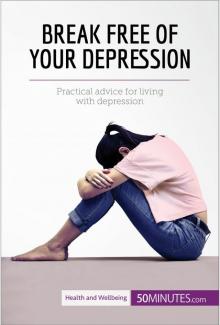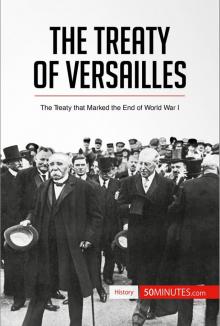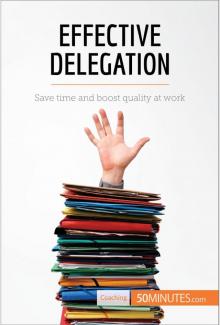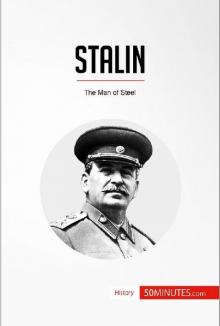- Home
- 50MINUTES. COM,
Stalin: The Man of Steel (History)
Stalin: The Man of Steel (History) Read online
Table of Contents
Stalin Key information
Introduction
Biography From the Church to Marxism
From the underground movement to supreme power
A chaotic personal life
Thirty years of dictatorship
Context The Russian Empire in crisis
The development of socialist ideas in Russia
From the Russian Empire to the USSR
The utopia of a global revolution and the construction of socialism
The Second World War
Highlights From Lenin to Stalin: seizing power
The establishment of a dictatorship
Rapid industrialisation
The forced collectivisation of the countryside
Governing through terror
Stalin against Hitler: the ‘Great Patriotic War’
A divide between two worlds
Impact A society suffering from shortages
An appalling death toll
De-Stalinisation and continuity
Communism after Stalin
Stalin and modern-day Russia
Summary
Find out more
Stalin
Key information
Born: 18 December 1878 – officially 21 December 1879 – in Gori, Georgia (Russian Empire).
Died: 5 March 1953 in Moscow.
Known for:the establishment of Communism in the USSR
the implementation of a repressive dictatorial regime
the rapid industrialisation of the USSR and land collectivisation
contribution to the Allied victory in the Second World War (1939-1945)
putting Eastern Europe under Soviet control and triggering the Cold War (1947-1991).
Introduction
Iosif (Joseph) Vissarionovich Dzhugashvili, known as Stalin, is one of the best-known politicians of all time. General Secretary of the Communist Party of the Soviet Union from 1922, then leader of the USSR from 1924 until 1953, he successfully dominated his country, followed by half of Europe, as well as promoting the spread of Communism in the rest of the world.
Born to an impoverished family in deepest Georgia and expelled from his religious school, Stalin turned to crime at a young age. Following the Russian Revolution and the toppling of the tsarist regime, he successfully gained access to the elite circle of the new Socialist leaders before seizing power and establishing a repressive dictatorial regime. Under Stalin’s rule, the bright future that the Revolution had heralded turned into a nightmare. He became a symbol of extreme Communism and the embodiment of modern barbarism, and made the USSR a model of totalitarianism. His reign stands out for its length and the scope of his actions, making him one of the most influential politicians of the 20th century.
After his death, the revelation of the extent of his crimes destroyed what was, undoubtedly, the greatest utopia of the 20th century. However, years after his death, he still inspires a certain amount of fascination. After the fall of the Soviet Union, his popularity increased again in Russia, where his legacy was reconsidered and idealised.
The man of many surnames
Throughout his life, Stalin had many surnames and pseudonyms. He was called Sosso (a diminutive of Joseph) during his childhood, and then took the name of Koba (an honourable bandit from a Caucasian adventure novel) when he went underground. Finally, he took on the surname Stalin, composed from the Russian word ‘stal’ meaning ‘steel’: ‘Stalin’ means ‘man of steel’.
Biography
Joseph Stalin.
From the Church to Marxism
Stalin was born on 18 December 1978 to a poor family who lived in the town of Gori, Georgia. His mother, Ekaterine Geladze (1858-1937), was a devoutly religious, ambitious and protective woman who worked as a maid for wealthy families. Besarion Dzhugashvili (c. 1850-1909), his father, was a cobbler and a violent alcoholic. Although the couple had four children, only Stalin survived, despite his fragile health: the smallpox he had caught as a child left him with a scarred face that would be carefully covered up in official pictures, while an accident involving a horse-drawn carriage permanently injured his left arm.
He attended the religious school in Gori, then the seminary in Tiflis (modern-day Tbilisi, capital of Georgia), where he demonstrated a talent for studying. Although he was a voracious reader and a good actor, he was also a difficult, authoritarian, aggressive, arrogant and merciless child, who refused to obey anything. He got good academic results until 1897, when he became less interested in his studies and more interested in politics, and lost his Christian faith. He was expelled two years later, ending his mother’s dream of seeing him become a bishop.
From the underground movement to supreme power
Stalin then began to campaign as part of small underground socialist groups in working-class towns in the Caucasus, stirring up unrest and increasing calls for strike action. He was arrested in 1902 by the Okhrana (the tsarist secret police) and sentenced to three years in exile in Siberia. After his escape, he joined the Bolshevik movement (a political movement which aimed to trigger a socialist revolution in Russia with the help of the alliance of peasants and workers) and met Lenin (Russian socialist revolutionary leader, 1870-1924), its founder, for the first time in 1905. Between 1908 and 1913, Stalin’s involvement in armed robberies and extortion (known as ‘expropriation of expropriators’, intended to obtain money for the Bolshevik party) earned him several arrests and sentences, but also the recognition of his peers.
After the Russian Revolution in 1917 and the Bolsheviks’ accession to power, Stalin was appointed People's Commissar for Nationalities' Affairs in Lenin’s new government. During the civil war (1918-1922) that followed, he was given special missions with the aim of fighting any opponents of the new regime. He stood out due to his obsession with conspiracies, random arrests, sentencing without a trial and violent retaliation, as well as for his poor military results. In March 1919, he became one of the five members of the Politburo (Political Bureau of the Central Committee of the Communist Party of the Soviet Union), then General Secretary of the Communist Party of the Soviet Union in 1922. Two years later, following Lenin’s death, he managed to eliminate his direct opposition for power and became the head of state.
The delegates of the 8th Congress of the Russian Communist Party. Stalin is on the second row.
A chaotic personal life
Stalin’s family circumstances reflected the chaos and tragedy of the rest of his life. In 1906, he married Ekaterina Svanidze (1885-1907), who died of an illness the following year, leaving him with a son, Yakov (1907-1943), whom he held in contempt to such a great extent that he would later refuse to exchange prisoners for him with the Germans during the Second World War. He remarried after the revolution to Nadezhda Alliluyeva (1901-1932), who committed suicide in 1932. Their son Vasily (1921-1962) was known in the aviation regiment of the Red Army for his lack of discipline, his alcoholism and his debauchery. Their beloved daughter Svetlana (1926-2011) sought political asylum in the United States, and moved there in 1967.
Did you know?
Stalin was described as a tireless worker, who was content with an austere way of life. He lived by a different timetable from most people’s (noon-4am) and imposed it on his main collaborators. He was an avid reader and owned several thousand books, including the great classics of Russian and European literature. He was also a great lover of music and cinema.
Thirty years of dictatorship
When he became head of state, he imposed a personal power and established a totalitarian Communist regime. Land and means of production
were nationalised and used to help the country’s rapid industrialisation. Any real or suspected opponents were eliminated or sent to labour camps during the Great Purge, and anti-establishment or suspect groups were deported to remote regions. Religion was also outlawed and cultural life was used to serve the new regime and its leader’s cult of personality.
After the German invasion in June 1941 during the Second World War, the USSR joined the war on the Allied side. The State slightly reduced the ideological pressure it exerted over its people, while ensuring that nationalist sentiment against the invader was intensified. Following their final victory, the USSR joined the inner circle of major world powers. This victory also increased Stalin’s popularity within his country, promoting and intensifying his cult of personality. However, the country’s devastation and the worsening ideological repression that characterised the following years destroyed the population’s hopes of leading a better life after the war.
The end of the Nazi threat revived the ideological conflict between capitalists and Communists. Western democracies prepared to fight against Communist desires for expansion across the world: this was the beginning of the Cold War.
Ageing and physically worn, Stalin died following a stroke on 5 March 1953 in his house in Kuntsevo (a municipal district of Moscow), only a few years after the beginning of the hostilities and the formation of the two blocs.
Context
The Russian Empire in crisis
When Stalin was born, the Russian Empire (which then included Finland, the Baltic countries, part of Poland, Byelorussia, Ukraine, the Caucasus and a large part of Central Asia) had been ruled by the Romanov dynasty for almost 300 years. Although the state was going through a difficult period and its political model was disputed, the tsars simply refused to establish a parliamentary or constitutional regime, further trapping the country in autocracy and immobilism. Alexander II (1818-1881), known as Alexander the Liberator, launched a programme of reforms that was interrupted by his assassination and the opposition of his son, Alexander III (1845-1894). At the end of his reign, the latter thus left a state plunged into a serious social, political, agricultural and industrial crisis to his successor, Nicholas II (1868-1918).
Tensions mounted and peaked on 22 January 1905 in St. Petersburg, when the Imperial Guard opened fire on a workers’ demonstration that had convened to ask the tsar for greater social justice. This event, known as Bloody Sunday, was the starting point for growing unrest which would eventually lead to the revolution a decade later. It was followed by a series of strikes in large cities and peasant uprisings in the countryside. In October, the tsar agreed to create a constitution and an elected parliament, the Duma, which in reality had almost no power.
Bloody Sunday: Shooting Workers Near The Winter Palace January 9, 1905, painting by Ivan Vladimirov.
The development of socialist ideas in Russia
At the beginning of the 20th century, most educated Russians wanted to see political changes akin to those that were taking place elsewhere in Europe, and yearned for a greater involvement in public life as well as the people’s liberation. However, alongside moderate movements, which were asking for reforms in the context of the existing system, were more radical movements, which were in favour of a total overhaul of the regime. They rejected the capitalism chosen by Western European countries and campaigned for the establishment of socialism.
The Russian Social Democrats founded their first party in 1898. They were inspired by the ideas of Karl Marx (German socialist theorist and revolutionary, 1818-1883), which had been introduced in Russia at the end of the 19th century, and dreamed of implementing a classless society through a revolution of the proletariat. In 1903, they split up into the Bolsheviks, led by Lenin, who wanted to create a centralised party organised into a hierarchy and launch an immediate socialist revolution, and the Mensheviks, led by Julius Martov (1873-1923), who preferred the idea of gaining a large following and progressively moving towards socialism. These opposing factions worked secretly to spread their ideas. In fact, strikes were banned and violently repressed, while trade unionists and opponents were hounded by the tsarist police.
From the Russian Empire to the USSR
After entering the First World War (1914-1918) against Germany and Austria-Hungary, the Imperial Russian Army suffered many defeats and considerable losses between 1914 and 1916. Demoralisation and shortages caused strikes and riots in cities at the start of 1917. The deputies of the State Duma then demanded the abdication of the tsar, who conceded to their demand on 15 March 1917: this was the February Revolution. The Provisional Government from the Duma was thus formed, but its authority was weak and great disorganisation reigned throughout the country.
Lenin stirring up the crowd.
Lenin thus propagated the idea of overthrowing the Provisional Government through an armed insurrection, and rallied the main Bolshevik leaders to his opinion: this was the October Revolution. The revolutionaries seized strategic points around St. Petersburg and mounted an attack on the Winter Palace, the seat of the Provisional Government, on the evening of 6 November. This was a coup d’état that the world witnessed. The following morning, Lenin announced that the Bolsheviks had seized power. He was now the leader of the new government, in which he appointed Stalin to the position of People’s Commissar for Nationalities’ Affairs. A few months later, the Bolsheviks put an end to the war with Germany via the Treaty of Brest-Litovsk (3 March 1918), at the cost of heavy territorial losses. Shortly afterwards, the Red Army was created and Moscow became the capital.
No sooner had it been established than the new regime already had to face opposition, including from the working classes. It also met with resistance from enemy parties: the revolutionary socialists established an independent government, while tsarist officers created their own army. There was therefore a confrontation between the White Army (opposing the Bolsheviks) and the Red Army, plunging the country into the depths of civil war. Openly hostile to Bolshevism, foreign powers supported the White Army by sending military contingents, before intervening by arming the White Army’s generals. The military conflicts did not end until 1920 with the Red Army’s victory.
In December 1922, the new state, which encompassed Russia, Ukraine, Byelorussia and Transcaucasia, adopted the name of the USSR (Union of Soviet Socialist Republics) and a constitution at the beginning of 1924. The Bolshevik party renamed itself the Communist Party and became the only legal political party.
The utopia of a global revolution and the construction of socialism
For Lenin and Trotsky, the Soviet revolution was only the starting point for a greater movement, the global revolution, in which the USSR became the first setting of a popular insurrection that extended beyond its borders. Comintern (the Communist International) was created in March 1919 in order to group the Communist parties of all countries within one international organisation. It was led by the USSR, which used it to try to destabilise or overturn the established powers. Throughout the 1920s, Soviet leaders thus kept a lookout for the precursory signs of conflict between capitalist countries that could possibly lead to a Communist revolution, while trying to normalise their diplomatic relations with these countries to prevent the creation of a new capitalist front against the USSR. No Communist revolution took place in Western Europe. As such, the counter-offensive launched by the Red Army at the end of the civil war (1920) against Poland, which had invaded Ukraine, was met with great patriotic resistance and Stalin’s unfamiliarity with strategic combat. This failure, followed by that of Communist revolutionary attempts in Hungary (1919), Germany (1921 and 1923), Bulgaria (1923) and China (1927), put an end to the dream of a global revolution. Finally, the economic crisis of 1929 was not propitious for anti-capitalism and the rise of Communism, but rather for the growth of nationalist or fascist movements.
Stalin, who did not believe in the global revolution and even feared its consequences, was convinced that their prior
ity should be the interests of the Soviet state rather than those of the international Communist movement. From 1928 onwards, his theory of ‘Socialism in One Country’ was his main policy. Until 1933, the USSR therefore concentrated on the fight against the European social democrat parties, which were considered too moderate and therefore deviant. However, by preventing the Communist Party from getting close to the social democrats in Germany, Stalin’s policy actually enabled the rise of Adolf Hitler’s National Socialist German Workers’ Party.
Aware of the danger, Soviet foreign policy did a U-turn and the USSR grew closer to Western democracies, while trying to keep Germany on their side to avoid an armed conflict breaking out, which it was unable to deal with. It also promoted the union of left-wing movements to block fascism. In 1936, these popular fronts were winning elections, notably in Spain, where an attempted military coup d’état, as a response to the victory of the Spanish left, ended after three years of civil war with General Franco’s (1892-1975) seizing power, despite the discreet aid offered by the USSR to the republican side. In response to this, Japan and Germany, later joined by Italy, Hungary and Spain, signed the Anti-Comintern Pact in 1936, making the fear of capitalist encirclement, which had been circulated by Soviet propaganda for a long time, a reality.
The Second World War
After much hesitation, the USSR chose to ally itself with Germany instead of with Western democracies. This purely practical alliance of circumstance allowed Germany to invade Poland on 1 September 1939 without fearing Soviet intervention. Two days later, Britain and France declared war on Germany. On 17 September, the USSR invaded Poland as well, as it had old scores to settle. Gradually, the war spread.

 Break Free of Your Depression
Break Free of Your Depression The Treaty of Versailles
The Treaty of Versailles Effective Delegation
Effective Delegation Stalin: The Man of Steel (History)
Stalin: The Man of Steel (History)